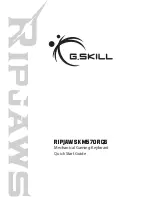
11-4
Glossary
Page
A set of performance or programming parameters that appear as a group in the
display. The entry level page for each mode appears when you select the mode. Most
other pages are selected with the soft buttons, from within an editor.
Parameter
A programming feature. The name of the parameter describes the function it
controls—transposition, for example. Each parameter has a value associated with it,
which indicates the status of the parameter.
Pixel
A contraction of “picture element.” The K2661’s display consists of a screen with
small square dots (the pixels). Each pixel lets light through or blocks it depending on
whether it is receiving an electrical charge. The combination of light and dark dots
creates a pattern that you recognize as text or graphics. The K2661’s display is
240-by-64 pixels, in other words, 64 horizontal rows, each containing 240 pixels, for a
total of 15360 pixels.
Program
The K2661’s basic performance-level sound object. Programs can consist of up to (32
layers; each layer has its own keymap (set of samples) and sound-processing
algorithm.
Program Editor
The set of parameters that lets you modify the sound of ROM or RAM programs.
Enter the Program Editor by pressing the EDIT button while in Program mode, or any
time the currently selected parameter has a program as its value.
RAM
Random Access Memory, one of the two basic types of computer memory. RAM can
be both read from and written to. When you load samples into the K2661 they are
stored in sample RAM (and are not saved across power cycles). When you save a
program you’ve created, you’re writing to program RAM (P/RAM). P/RAM is
battery-backed, so it is saved from session to session. Compare ROM.
ROM
Read Only Memory, one of the two basic types of computer memory. You can retrieve
the information stored in ROM, but you can’t write (save) new information to it. The
onboard sounds of your K2661 are stored in ROM.
Sample
A digital recording of a sound that can be assigned to a keymap as part of the process
of building a program. Samples are stored in ROM (factory-installed) or in RAM
(loaded from disk).
SCSI
Pronounced “scuzzy,” this acronym stands for Small Computer Systems Interface. It’s
simply a standardized form of information exchange that allows any SCSI equipped
device to communicate with any other SCSI device. A SCSI device—a computer, hard
disk, printer, just about anything that sends or receives information in standardized
form—is connected via special cables to their SCSI ports. This con
fi
guration is much
faster than serial information exchange, the precursor to SCSI.
SMDI
Pronounced “smiddy,” this acronym stands for SCSI Musical Data Interchange. It’s a
new format for data transfer, based on the SCSI format, which uses parallel input/
output rather than serial, as used by MIDI and standard SCSI operations. This enables
data to
fl
ow much faster. You can use SMDI to transfer samples to and from the K2661
using software packages from Passport and Opcode.
SMF
Standard MIDI File. MIDI Type 0
fi
les are single track, while MIDI Type 1
fi
les are
multi-track. The K2661 can read and write Type 0
fi
les and read Type 1
fi
les.
Semitone
In “Western” music, the standard interval between the twelve notes in the scale. There
are twelve semitones to an octave. The interval between C and C
#
is one semitone.
Содержание K2661
Страница 18: ...2 4 LFOs LFO Shapes...
Страница 34: ...3 16 DSP Algorithms...
Страница 54: ...5 4 MIDI Note Numbers Note Numbers for Percussion Keymaps...
Страница 72: ...7 10 System Exclusive Protocol K2661 System Exclusive Implementation...
Страница 82: ...9 4 Upgrading Sample Memory Choosing and Installing a SIMM for K2661 Sample Memory...
Страница 334: ...10 252 KDFX Reference KDFX Algorithm Specifications...
Страница 340: ...11 6 Glossary...
Страница 382: ...12 42 Triple Modular Processing Alphanumeric Buttonpad Entries for DSP Functions...
Страница 392: ...B 6 SysEx Control of KDFX MSB and LSB...
Страница 442: ...D 20 Contemporary ROM Block Objects Controller Assignments Contemporary ROM Block...
Страница 490: ...H 12 General MIDI Standard Mode Controller Assignments...
Страница 492: ...I 2 Live Mode Objects Live Mode Programs...
Страница 498: ...K2661 Musician s Reference Index...
Страница 500: ......
















































